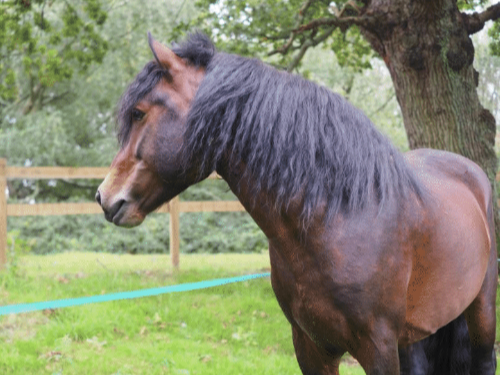A New Forest stallion who endured three days hanging from a tree and suffered life-threatening injuries has made a remarkable recovery.
Bullhill Major (‘Major’) is a homebred, who was one of the stallions who came through the New Forest Breed Society’s Futurity Scheme to help maintain a wide variety of quality bloodlines. He has produced several foals and has had the run of the forest for six years, but last summer his future lay in the balance following a serious accident.
At the beginning of June, it was noticed that Major and some mares had not been seen for a couple of days. It was an extremely hot period, so his owner, Suzanne Kempe, who runs a small New Forest pony stud and is a regular public speaker on the New Forest pony breed, thought he had gone to a cooler clearing, deeper in the forest.

Major and Suzanne Kempe his owner, riding out in the New Forest before the accident Credit: Patrick Kempe
However, a call on 4 June from the New Forest Agister on the third day revealed that Major had been found stuck straddled over a Beech branch extending from a fallen tree, with all four feet off the ground. It is unknown how he came to be in this position, but Suzanne believes he may have been trying to mount a mare who passed under the branch.
He was found by a pair of riders who alerted a local commoner and with the help of a chainsaw, Major was released from the branch, and taken to Seadown’s veterinary hospital in Hythe.

The offending Beech tree showing the chainsaw cut that had to be made to free the stallion. Credit: Suzanne Kempe
“Major is a stallion who is well known to the practice, having known him as a foal and vetting him for his New Forest stallion licencing, he has always been a firm favourite at the practice,” said Laura Trigg, Seadown’s Clinical Director and equine veterinary surgeon.
“Being a stoical New Forest pony, he perhaps didn’t appear to be as sick as he was [when he arrived following his accident]. However, Karolina Kalka one of our equine vets took some bloods from him and realised he was suffering from severe dehydration and potentially going into kidney failure.
“Due to Major being effectively ‘hung’ from the tree branch he had severe pressure wounds in his inguinal and caudal abdominal region, these wounds again looked benign, however Karolina quickly realised that they were extensive and deep [view photos of the wounds here and here – please note images are very graphic], and the overlying skin tissue was dead and necrotising. This could potentially lead to a life – threatening septicaemia if inflammatory factors from the dying skin and muscle tissues was released into the blood stream.”
Major was put onto IV fluids and started on antibiotics and pain relief. He was given intensive care over the
weekend that he was admitted and started to improve clinically, and his kidney parameters improved.
Over time the skin overlying Major’s wounds started to slough off and the laborious task began of removing the dead tissue and cleaning the underlying exposed areas.
“Major has such an amazing temperament that we were able to clean and debride his wounds without any sedation which enabled Suzanne his owner to take over a lot of the wound care at home,” continued Laura. “Major was discharged from the hospital a few days after he was admitted, and Suzanne left with an armful of medications and wound dressings that she judiciously used and applied every day. She kept us regularly updated with wound photos and we examined Major ourselves at regular intervals.
“Over time the dead skin was removed and healthy granulation tissue emerged. As Major was otherwise a fit and
healthy pony the regeneration of his skin tissue has been remarkably quick [see his wound progress by November here].
“This case has been a testament firstly to Major and his fabulous temperament, his dedicated owner Suzanne and the team effort from the vets and nurses at Seadown Equine who have painstakingly managed Major’s wounds and helped achieve such a successful outcome”
Major’s owner, Suzanne Kempe said Major was the “perfect patient” and was very sensible on box rest. His wounds are now almost completely healed [see picture here].
“Nature has been a wonderful healer – simple Aloe Vera gel and/or Manuka Honey as required,” she added. “Luckily Major was very fit and therefore able to fight off any possible infections with no need for antibiotics after the first nine days. My husband who is a healer also gave him ‘healing’ sessions throughout.
“My only advice to other horse owners is that horses will always get into trouble and difficulties but it’s always important to remain positive and always follow your vets advice…and of course, be very patient!”
Top image of Major recovering at home and wound images by Suzanne Kempe










